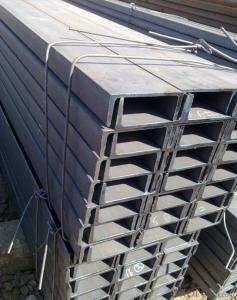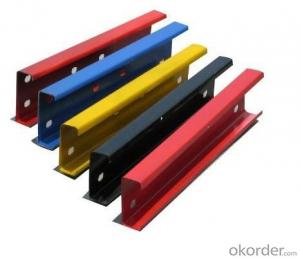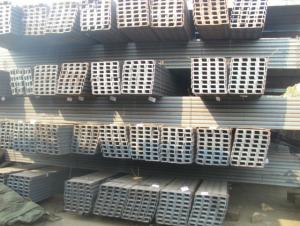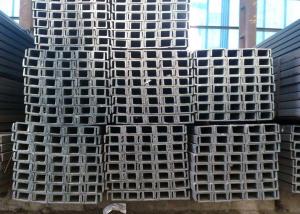GB Standard Steel Channel 300mm with High Quality
- Loading Port:
- China Main Port
- Payment Terms:
- TT or LC
- Min Order Qty:
- 25 m.t
- Supply Capability:
- 10000 m.t/month
OKorder Service Pledge
OKorder Financial Service
You Might Also Like
Product Description:
Specifications of GB Standard Steel Channel 300mm with High Quality:
1. We are definitely specializing in manufacturing and supplying channel steel.
| Standard: | GB/T 6723-86 |
| Material/Grade: | Q235 |
| Sizes: | 300mm |
| Sales Volume/Year: | 3000MT |
| Destination Area: | Middle East, Africa, Southeast Asia |
2.Size, Length and Mass.
| Size(mm) | Length(m) | Mass(Kg/m) |
| 300*85*7.5 mm | 6m, 12m | 34.463 |
| 300*87*9.5mm | 6m, 12m | 39.173 |
| 300*89*11.5mm | 6m, 12m | 43.883 |
Package & Delivery of GB Standard Steel Channel 300mm with High Quality:
The steel u channel will be packed in bundle with steel wire at each end of every bundle and color marking in order to help the customer to recognize his goods more easily at sight.
And steel u channel could be loaded into 20ft or 40ft container, or by bulk cargo. If the weight of each bundle reaches less than 3.5 mt, the loading by break bulk cargo should be choosed. When the weight of each bundle reaches less than 3mt, the loading by container should be choosed.
As for the transportaion from mill to loading port, the truck will be usually used. And the maximum quantity for each truck is 40mt.
All in all, we could do in accordance with customer's request.
FAQ:
Q1: How soon can we receive the product after purchasement?
A1: Within three days of placing an order, we will begin production. The specific shipping date is dependent upon international and government factors, but is typically one month.
Q2: How do you guarantee the quality of our products?
A2: We have established an advanced quality management system which conducts strict quality tests at every step, from raw materials to the final product. At the same time, we provide extensive follow-up service assurances as required.
Q3: The prices are invoicing on theoritical weight or on actual weight?
A3: We can do it in both manners, according to the customers' request.
Images of GB Standard Steel Channel 300mm with High Quality:


If you would like to get our price, please inform us the standard/material, size and quantity. Thank you very much.
- Q: Are steel channels suitable for agricultural applications?
- Yes, steel channels are suitable for agricultural applications. They are strong, durable, and have high load-bearing capacity, making them ideal for constructing farm buildings, fences, and equipment supports. Additionally, steel channels are resistant to harsh weather conditions and provide excellent structural stability, ensuring long-lasting performance in agricultural settings.
- Q: Are steel channels fire-resistant?
- Yes, steel channels are generally considered to be fire-resistant. Steel has a high melting point and does not contribute fuel to a fire, making it a preferred material for construction in fire-prone areas. Additionally, steel channels can be further enhanced with fire-resistant coatings or insulation to provide even greater protection against fire damage.
- Q: What is the maximum load-bearing capacity of channel 12M span 100?
- When flat, the span of one meter is concentrated, and the solution is as follows: M=W[,]=15610*215=3356150N-mm=3.356kN-mM=L/4*N+q*L*L/8N= (M-0.1*1*1/8), *4= (3.356-0.1*1*1/8), *4=13.374kN (1.3 tons)When standing, the span of one meter is concentrated, and the solution is as follows: M=W[,]=39660*215=8526900N-mm=8.527kN-mM=L/4*N+q*L*L/8N= (M-0.1*1*1/8), *4= (8.527-0.1*1*1/8), *4=34.058kN (3.4 tons)
- Q: In the steel structure of steel purlin 160*60*20*2.5 is what mean
- Steel structure is mainly made of steel material, and it is one of the main types of building structure. The structure is mainly composed of steel beams and steel plates, such as steel beams, steel columns, steel trusses and so on. Each component or component is usually connected with welds, bolts or rivets. Because of its light weight and simple construction, it is widely used in large factories, stadiums, super high-rise and other fields.
- Q: What are the different methods for protecting steel channels from water intrusion?
- Depending on the specific requirements and conditions, there are various methods available to protect steel channels from water intrusion. Presented below are some commonly used approaches: 1. Coating: A highly effective method to prevent water intrusion is the application of protective coatings on the surface of steel channels. Epoxy, polyurethane, or zinc-rich paints can create a barrier that prevents water from coming into contact with the steel, thereby reducing the risk of corrosion. 2. Galvanization: In environments with high humidity or exposure to corrosive substances, galvanizing steel channels by coating them with a layer of zinc proves particularly effective. This sacrificial barrier acts against corrosion and provides enhanced protection. 3. Waterproofing membranes: Utilizing waterproofing membranes on the surface of steel channels helps prevent water from seeping into the material. These membranes, made of materials like bitumen, rubber, or PVC, offer a protective barrier against water intrusion. 4. Sealants: The use of sealants, such as silicone or polyurethane caulk, effectively seals gaps or joints in steel channels, ensuring water does not penetrate these vulnerable areas. Regular inspection and replacement of sealants are essential to maintain their effectiveness. 5. Drainage systems: Proper installation of a drainage system around steel channels redirects water away from the structure. This can be achieved through the implementation of gutters, downspouts, and appropriate grading to ensure water flows away from the channels, reducing the risk of water intrusion. 6. Maintenance and inspection: Regularly maintaining and inspecting steel channels is crucial to identify any signs of water intrusion or corrosion. Promptly addressing any issues, such as repairing damaged coatings or sealants, can prevent further damage and ensure long-term protection. It is important to consider that the effectiveness of these methods may vary depending on factors like the specific environment, water exposure, and the quality of materials used. Consulting professionals and adhering to industry standards and guidelines is highly recommended to ensure the most suitable method is employed for protecting steel channels from water intrusion.
- Q: Are steel channels available in different colors?
- No, steel channels are typically not available in different colors. Steel channels are primarily made from carbon steel or stainless steel, and these materials have a natural metallic appearance. However, it is possible to paint or coat steel channels in different colors if desired. This can be done using methods such as powder coating or liquid paint coatings. By applying a layer of paint or coating to the steel channels, they can be customized to match specific color requirements or to provide additional protection against corrosion.
- Q: Can steel channels be used in stadium construction?
- Yes, steel channels can be used in stadium construction. Steel channels, also known as steel C-channels or U-channels, are commonly used in construction due to their strength, durability, and versatility. They are particularly useful in stadium construction as they can be used for a variety of purposes such as supporting structural elements, framing, creating architectural features, and providing additional strength to the overall structure. Steel channels are often used to create the framework for seating areas, walkways, and staircases in stadiums. Additionally, they can be used to support large screens, scoreboards, lighting fixtures, and other equipment necessary for stadium operations. The use of steel channels in stadium construction ensures a sturdy and reliable structure that can withstand the heavy loads and stresses that stadiums typically endure.
- Q: What are the different applications of steel channels?
- There are numerous industries that make use of steel channels for various applications. Here are some examples of how steel channels are utilized: 1. In the construction industry, steel channels are widely utilized for different structural purposes. They serve as beams, columns, and purlins in building frames, providing exceptional strength and stability to support heavy loads. 2. When it comes to infrastructure, steel channels play a vital role. They are crucial in the construction of bridges, flyovers, and highways, offering essential support and reinforcement to these structures. 3. The manufacturing industry also relies on steel channels for creating frames, racks, and supports for machinery and equipment. These channels are commonly used in industrial warehouses and factories to establish a sturdy framework for storage systems and production lines. 4. In the automotive industry, steel channels are extensively used for manufacturing various vehicle components, including chassis, frames, and suspension systems. They possess high strength and durability, ensuring the safety and stability of vehicles. 5. Within the electrical industry, steel channels are employed for cable management and support systems. They provide a secure and robust pathway for electrical wires and cables, ensuring proper organization and protection against damage. 6. Steel channels also find applications in the marine industry due to their corrosion resistance properties. They are utilized in the construction of ships, boats, and offshore structures, offering structural support and withstanding the harsh marine environment. 7. Furniture manufacturing often involves the utilization of steel channels, particularly in the creation of metal frames for chairs, tables, and shelving units. These channels offer stability and durability, making them ideal for heavy-duty furniture designs. 8. In the agricultural sector, steel channels are employed for various purposes. They serve as support structures for greenhouses and can also be used for creating sturdy fencing systems. Overall, steel channels are versatile structural components that have a wide range of applications across different industries. Their strength, durability, and versatility make them a preferred choice for construction and manufacturing purposes.
- Q: Channel 10, 6 meters long, two ends fixed, how much weight can the middle bear?
- For concentrated loads: M=1/4PL+1/8gL, =1/4 * 600P+1/8 * 0.1 * 600 * =39.4 * 1400=55160kg-cmP= (55160-1/8 x 0.1 x 600 x) x 4/600=337.73kg, that is, midspan can withstand the force of 337.73kg.
- Q: Can steel channels be used for creating decorative elements?
- Yes, steel channels can be used for creating decorative elements. They can be shaped, welded, and finished to create various designs and patterns, making them versatile for decorative purposes in architecture and interior design.
Send your message to us
GB Standard Steel Channel 300mm with High Quality
- Loading Port:
- China Main Port
- Payment Terms:
- TT or LC
- Min Order Qty:
- 25 m.t
- Supply Capability:
- 10000 m.t/month
OKorder Service Pledge
OKorder Financial Service
Similar products
Hot products
Hot Searches
Related keywords




























